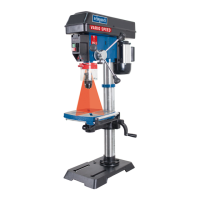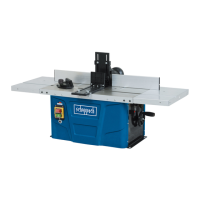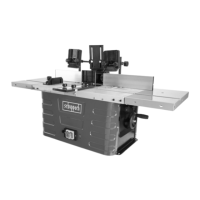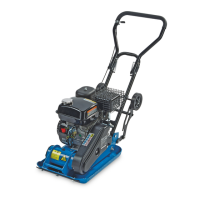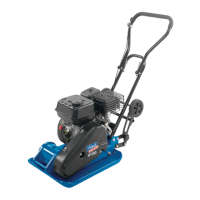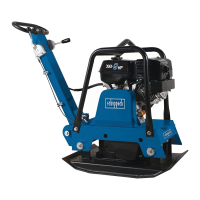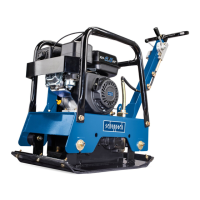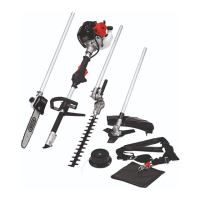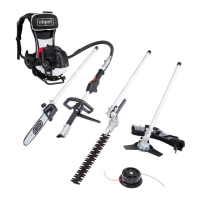www.scheppach.com
GB
|
31
If you hold the workpiece in your hand, you cannot
stop it turning and therefore prevent yourself get-
ting injured.
• Do not attempt to drill a workpiece that does
not have a at surface unless you are using a
suitable support.
• Never start the drill with the bit pressed against
the workpiece.
• Switch the electric tool o immediately if the
tool attachment blocks. The tool attachment
blocks if:
- the power tool is overloaded or
- it is tilted in the workpiece to be processed.
• Do not touch the tool attachment after working
until it has cooled down. The tool attachment be-
comes very hot when working.
• Inspect the cable on a regular basis and only
have damaged cables repaired by an authorised
customer service centre. Replace damaged ex-
tension cables. This ensures that safety of the
electric tool is maintained.
• Store the unused electric tool safely. The stor-
age location must be dry and lockable. This pre-
vents the electric tool getting damaged by storage
or being operated by inexperienced people.
• Never leave the electric tool until it has come to
a complete standstill. Tool attachments that are
still moving can cause injuries.
• Do not use the electric tool with a damaged ca-
ble. Do not touch the damaged cable and pull
the mains plug out if the cable gets damaged
while working. Damaged cables increase the risk
of an electric shock.
• Follow the instructions for lubrication and for
tool replacement.
Attention: Laser beamtrahlung
Do not look into the beam
Laser class 2
Protect yourself and you environment from acci-
dents using suitable precautionary measures!
• Do not look directly into the laser beam with un-
protected eyes.
• Never look into the path of the beam.
Service
a. Only have your electric tool repaired by qual-
ied specialists and only with original spare
parts.
This ensures that safety of the electric tool is main-
tained.
Safety instructions for bench drills
• Never make warning signs on the electric tool
illegible.
• Secure the electric tool to a solid, level and hori-
zontal surface. If the electric tool can slip or wob-
ble, the tool attachment cannot be guided evenly
and safely.
• Keep the work surface clean, except for the
workpiece to be processed. Sharp-edged drill-
ing debris and object can cause injuries.
Material mixtures are particularly dangerous. Light
metal dust can burn or explode.
• Set the correct speed prior to starting work. The
speed must be appropriate for the drilling diam-
eter and the material to be drilled. If the speed is
set incorrectly, the tool attachment may get stuck
in the workpiece.
• Only guide the tool attachment against the
workpiece when switched on. Otherwise, there
is a risk that the tool attachment will get stuck in
the workpiece and take the workpiece with it. This
can result in injuries.
• Do not place your hands in the drilling area
while the electric tool is running. There is a dan-
ger of injury if you come into contact with the tool
attachment.
• Never remove drilling debris from the drilling
area whilst the electrical tool is running. Always
move the drive unit into the resting position and
switch the electric tool o.
• Do not remove any drilling debris with bare
hands. There is a particular danger of injury due
to hot and sharp-edged metal debris.
• Break long pieces of drilling debris by interrupt-
ing the drilling process by turning the wheel
backwards. Long pieces of drilling debris pose a
danger of injury.
• Keep the handles dry, clean and free of oil and
grease. Greasy, oily handles are slippery and result
in a loss of control.
• Use the clamping devices to clamp the work-
piece in place. Do not work with workpieces that
are to small to be clamped in place.
